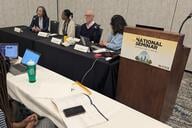You have /5 articles left.
Sign up for a free account or log in.
WASHINGTON – The majority of college students say their campuses feel inclusive of many different faiths, according to research presented here Friday, but only 3 percent of students say they actually participate frequently in interfaith programming on campus.
The Campus Religious and Spiritual Climate Survey, discussed during a presentation at the annual meeting of the Association of American Colleges and Universities, examined how academic, social, and functional features of a college influence the way students interact with each other across religions. The survey collected responses from more than 8,000 students from 38 public and private colleges and universities (the latter included Catholic, mainline Protestant, and evangelical institutions) between 2011 and 2014. According to the survey's findings, feelings of acceptance vary widely between religions, types of institutions, and even years of college.
“It’s pretty difficult to not interact with someone of a different worldview on campus,” Alyssa Bryant Rockenbach, associate professor of higher education at North Carolina State University and one of the researchers behind the survey, said. “But there are missteps and there is tension, and very few students are highly engaged.”
While colleges have never been more diverse, religiously or otherwise, attempts to build religious pluralism on campus aren't always met with enthusiasm. Earlier this month, Duke University reversed a policy announced just two days earlier that would have allowed Muslim students to offer a call to prayer on Friday afternoons from the campus chapel's bell tower. The weekly prayer service had already been held in the chapel's basement for years, but the inclusion of a call to prayer announcement drew intense criticism from some evangelical leaders. A university spokesman said "credible" security threats influenced Duke's decision to abandon the new policy.
Over all, 60 percent of students responding to the survey said that they felt their institution was “very” or “extremely” inclusive of diverse viewpoints regarding religion. But students from what the researchers call “a worldview majority” (students who identify as Protestant, Orthodox, or Roman Catholic Christians) felt more supported than those who were considered a “worldview minority” (students who belong to a range of less widely represented faiths such as Islam, Mormonism, Judaism, and Native American traditions).
While more than 75 percent of worldview majority students reported experiencing a high degree of support and freedom to express themselves, only 68 percent of worldview minority students said they felt similarly. About 65 percent of non-religious students reported feeling supported.
.jpg)
The divide was especially apparent in regard to whether a student has a physical space on campus where he or she can seek help for spiritual issues. More than 70 percent of worldview majority students said they had such a space on campus, compared to less than half of worldview minority students.
While nonreligious students reported feeling less supported than any other group, students perceive nonreligious students to be the most accepted group on campus. Nearly 60 percent of students said they felt that non-religious students were highly accepted on campuses. Only 35 percent of students felt that Mormon students were accepted. Gay, lesbian, bisexual, and transgender students reported the most hostility on campus, with 62 percent of lesbian students and 58 percent of gay students saying they had been discriminated against by someone with a religious worldview because of their gender identity or sexual orientation.
Muslim acceptance was highest at Catholic institutions and lowest at Protestant colleges. Christians and Mormons felt most accepted at public universities, and nonreligious students felt least accepted at private religious colleges. Students of color perceived campus interfaith climates more favorably than other students, the survey found, which the researchers said could be linked to the "nuances in institutional environments, affiliation with a range of campus subcultures, and engagement in unique experiences."
One commonality: as students of all kinds move through college, their perceptions of acceptance and support seem to worsen.
“First-year students perceive higher levels of acceptance of diverse worldview groups compared to students with more years of college,” the researchers wrote. “It may be that first-year students, who are still acclimating to campus, are less aware of discrimination than their more advanced peers.”
Just what chips away at a student's optimism during those years is not yet clear, but the researchers hope to gain a better understanding after they launch a new, longitudinal study this fall. That survey, the Interfaith Diversity Experiences & Attitudes Longitudinal Survey -- which was officially introduced at Friday's presentation -- will assess students at 120 colleges, checking in with them as freshmen, sophomores and soon-to-graduate seniors.
Matthew Mayhew, associate professor of higher education at New York University and another researcher behind the survey, said while the researchers have already found more than 100 colleges and universities that would like to participate in the project, some institutions have declined out of fear of further escalating interfaith tensions on campus.
“In the recruitment phase of these surveys, we have had colleges that say, ‘No, we’re not touching this because of that very issue,’ ” Mayhew said. “At the same time, others have said yes because of those conflicts. They’ve said, ‘Let’s take this issue head-on.’ The survey is not really looking at this through a conflict management lens, but it can be useful in uncovering some of the mechanics of conflict. Not explanatory, but useful.”
Mayhew said he hopes institutions participating in the two surveys will share the findings with students, faculty, and staff on campus. “Use this as an opportunity for reflection,” he said, “and it becomes an intervention.”
The researchers recommend that institutions desiring to engage more students in interfaith activities should avoid events like religious debates. These can be well-attended and generate good conversation, but they also help perpetuate the idea that one worldview is wrong or inferior compared to another, Rockenbach said. “Debates create an intense atmosphere rather than a situation where stories are shared,” she said. “Winning a debate privileges the worldview that won.”
Instead, the researchers said, interfaith activities should help students find common ground between groups. Community service projects are a popular and often effective activity, said Ben Correia, campus assessment manager at Interfaith Youth Core, which helped create the survey. Service projects account for about 70 percent of campus interfaith activities.
“It’s important to focus on a common action for a common good, so that students know there’s a reason they’re coming together,” Correia said. “They may want to evangelize and that’s fine, but it should be clear that if they get a no from another student, they should accept that and still want to work together. It helps that the two students can see that they don’t agree on everything but that they do both believe in helping the poor, for example.”




